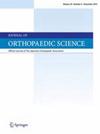Relationship between frailty and locomotive syndrome in older patients with degenerative cervical myelopathy: A retrospective longitudinal study
IF 1.5
4区 医学
Q3 ORTHOPEDICS
引用次数: 0
Abstract
Background
The management of degenerative cervical myelopathy (DCM), which often impairs lower extremity function and increases the risk of falls, is gaining recognition for its importance in an aging society. Despite the significant overlap between frailty and locomotive syndrome (LS) in older adults, their interaction in older DCM patients remains unclear. We aimed to determine the characteristics of older DCM patients with frailty, focusing on the association between frailty and LS.
Methods
We retrospectively examined the clinical records and imaging data of consecutive patients aged 65 years and above who underwent surgery for DCM at a single facility. Frailty and LS stage were diagnosed using the modified frailty index-11 and the 25-question Geriatric Locomotive Function Scale (GLFS-25), respectively.
Results
A total of 114 subjects were analyzed, among whom approximately 30% were diagnosed with frailty. DCM patients with frailty had significantly worse Japanese Orthopaedic Association Cervical Myelopathy Assessment Questionnaire (JOACMEQ) and GLFS-25 scores at baseline than did those without frailty. Moreover, DCM patients with frailty had significantly more advanced LS stage at baseline than did those without frailty. Meanwhile, no significant difference in the improvement in JOACMEQ and GLFS-25 scores were observed between those with and without frailty after surgery. More precisely, DCM patients with frailty experienced better improvement in lower extremity function based on the JOACMEQ than did those without frailty.
Conclusions
Our results demonstrated that older DCM patients had favorable outcomes following surgery regardless of frailty. Despite the significant association between frailty and LS in DCM patients, frailty did not negatively impact the improvement in LS in older DCM patients. These findings provide valuable information for both older DCM patients and their attending physicians that would help guide decisions about cervical spine surgery for DCM.
老年退行性颈椎病患者的虚弱与运动综合征之间的关系:回顾性纵向研究
背景:退行性颈椎脊髓病(DCM)通常会损害下肢功能并增加跌倒的风险,其治疗在老龄化社会中的重要性正日益得到认可。尽管老年人的虚弱和运动综合征(LS)之间存在明显的重叠,但它们在老年 DCM 患者中的相互作用仍不明确。我们旨在确定患有虚弱症的老年 DCM 患者的特征,重点关注虚弱症与运动综合征之间的关联:我们回顾性地检查了在一家医疗机构接受 DCM 手术的 65 岁及以上连续患者的临床记录和影像学数据。分别使用改良虚弱指数-11 和 25 题老年运动功能量表(GLFS-25)诊断虚弱程度和 LS 阶段:共分析了 114 名受试者,其中约 30% 被诊断为体弱。日本骨科协会颈椎病评估问卷(JOACMEQ)和 GLFS-25 的基线得分明显低于无体弱症状的 DCM 患者。此外,与非体弱者相比,体弱的 DCM 患者在基线时的 LS 分期明显更晚。同时,术后体弱和非体弱患者的 JOACMEQ 和 GLFS-25 评分在改善程度上没有明显差异。更确切地说,根据 JOACMEQ 的评分,体弱的 DCM 患者下肢功能的改善程度要好于非体弱者:我们的研究结果表明,无论体弱与否,老年 DCM 患者术后都能获得良好的治疗效果。尽管 DCM 患者的体弱与下肢功能明显相关,但体弱并不会对老年 DCM 患者下肢功能的改善产生负面影响。这些研究结果为老年 DCM 患者及其主治医生提供了有价值的信息,有助于指导 DCM 颈椎手术的决策。
本文章由计算机程序翻译,如有差异,请以英文原文为准。
求助全文
约1分钟内获得全文
求助全文
来源期刊

Journal of Orthopaedic Science
医学-整形外科
CiteScore
3.00
自引率
0.00%
发文量
290
审稿时长
90 days
期刊介绍:
The Journal of Orthopaedic Science is the official peer-reviewed journal of the Japanese Orthopaedic Association. The journal publishes the latest researches and topical debates in all fields of clinical and experimental orthopaedics, including musculoskeletal medicine, sports medicine, locomotive syndrome, trauma, paediatrics, oncology and biomaterials, as well as basic researches.
 求助内容:
求助内容: 应助结果提醒方式:
应助结果提醒方式:


